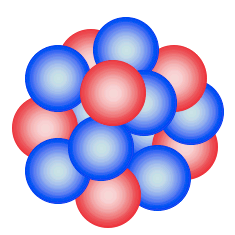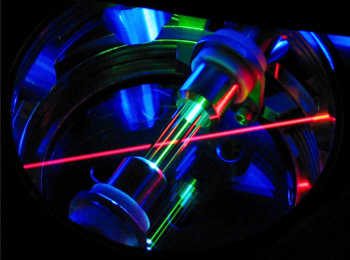Thorium Nuclear Clock
March 26, 2012
I wrote about a highly accurate
ytterbium atomic clock in a
previous article (Ytterbium Atomic Clock, March 16, 2012). This clock has an estimated timekeeping error of just thirty seconds in the
age of the universe.
The ytterbium clock was an atomic clock, since it's timekeeping depended on an
atomic property, the transition in an
electron energy level.
Physicists at
Georgia Tech, the
University of New South Wales and the
University of Nevada have been investigating a novel timekeeping device that doesn't depend on electrons. It's a
nuclear clock of unparalleled accuracy that's based on an excitation of the
nucleus of
thorium-229. The timekeeping accuracy of this nuclear clock is estimated to be one part in 10
19, or a tenth of a second over the age of the universe.[1-2]
In a paper scheduled to appear in
Physical Review Letters, the research teams from the
Georgia Tech physics department, the
University of Nevada Department of Physics and the
University of new South Wales School of Physics propose using an orbiting
neutron in the thorium-229 nucleus as the clock
frequency element. The accuracy arises from the fact that neutrons in a nucleus are
tightly bonded, and atomic nuclei are well isolated from their surroundings.[1-2]

A representation of an atomic nucleus.
The protons (red) and neutrons (blue) are not static. They are in constant motion.
In reality, it's just a ball of quantum goo, but that doesn't make a very nice picture.
(Via Wikimedia Commons))
Although nuclei are isolated from most
external forces, they can still be perturbed, so certain measures are required to achieve the intended accuracy. Thorium
ions are isolated in an
ion trap, where
Coulombic repulsion keeps them separated. The ions are then cooled to a
temperature of a few tens of
millikelvins, near
absolute zero. This is usually done by
laser cooling, but the thorium-229 ions must be laser excited for the timekeeping, so an indirect cooling approach is used.

Thorium ions in a radio frequency ion trap.
The 229Th ions are laser cooled by an indirect process to a temperature close to absolute zero.
(Georgia Tech image by Corey Campbell))
The cooling is done by mixing a single
thorium-232 ion with the thorium-229 timekeeping ion. The electrons of the heavier thorium-232 ion are affected by a different laser
wavelength than those of the thorium-229, so cooling of the thorium-232 ion is possible. The thorium-232 ion then cools the thorium-229 time-keeping ion indirectly.[1]
At this point, no clock has been made, although there's been considerable progress towards that goal. Nuclear clocks were first proposed in 2003.[1] One major problem is that the
ultraviolet laser wavelength required for the
oscillation is not known. Its extremely narrow
linewidth makes this a difficult search. Says
Corey Campbell, a Georgia Tech post-doc who is the paper's principal author, "People have been looking for this for 30 years... It's worse than looking for a needle in a haystack. It's more like looking for a needle in a million haystacks."[1]

Pretty as a picture - A chain of 29 laser-cooled Th3+ atoms suspended in an RF ion trap. The atom spacing occurs because of Coulombic repulsion. (Georgia Tech image by Corey Campbell))
Is such a high timekeeping precision needed? One of the paper's coauthors,
Victor V. Flambaum of the University of New South Wales, remarked, "It would allow scientists to test fundamental physical theories at unprecedented levels of precision and provide an unmatched tool for applied physics research."[2]
Another coauthor,
Alex Kuzmich of Georgia Tech, said, "If you give people a better clock, they will use it... For most applications, the atomic clocks we have are precise enough. But there are other applications where having a better clock would provide a real advantage."[1]
This research was supported by the
Office of Naval Research, the
National Science Foundation and the
Gordon Godfrey fellowship.[1]
References:
- John Toon, "Building a Better Clock: Researchers Develop Blueprint for Nuclear Clock Accurate Over Billions of Years," Georgia Tech Press Release, March 19, 2012.
- Nuclear clock may keep time with the Universe, University of New South Wales Press Release, March 8, 2012.
Permanent Link to this article
Linked Keywords: Ytterbium; atomic clock; age of the universe; atom; atomic; electron; energy level; physicist; Georgia Institute of Technology; Georgia Tech; University of New South Wales; University of Nevada; atomic nucleus; nuclear; nucleus; thorium-229; Physical Review Letters; Georgia Tech physics department; University of Nevada Department of Physics; University of new South Wales School of Physics; neutron; frequency; nuclear force; proton; quantum mechanics; Wikimedia Commons; Lorentz force; ion; ion trap; Coulombic repulsion; temperature; millikelvin; absolute zero; laser cooling; Corey Campbell; thorium-232; wavelength; ultraviolet; oscillation; linewidth; Victor V. Flambaum; Alex Kuzmich; Office of Naval Research; National Science Foundation; Gordon Godfrey fellowship.